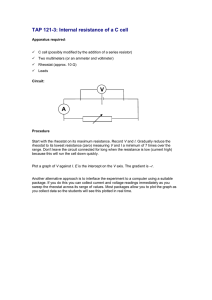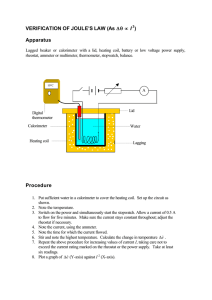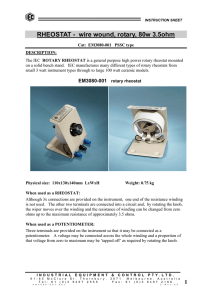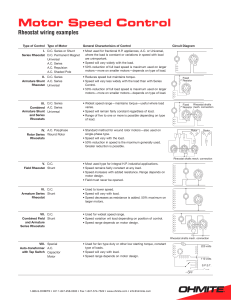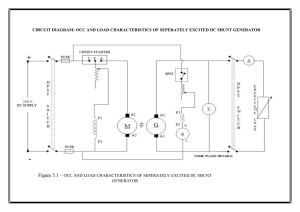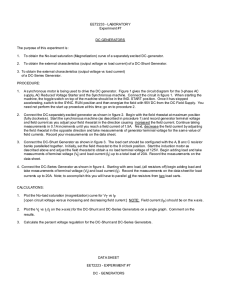The Theory of the Dodge Design Rheostat
advertisement
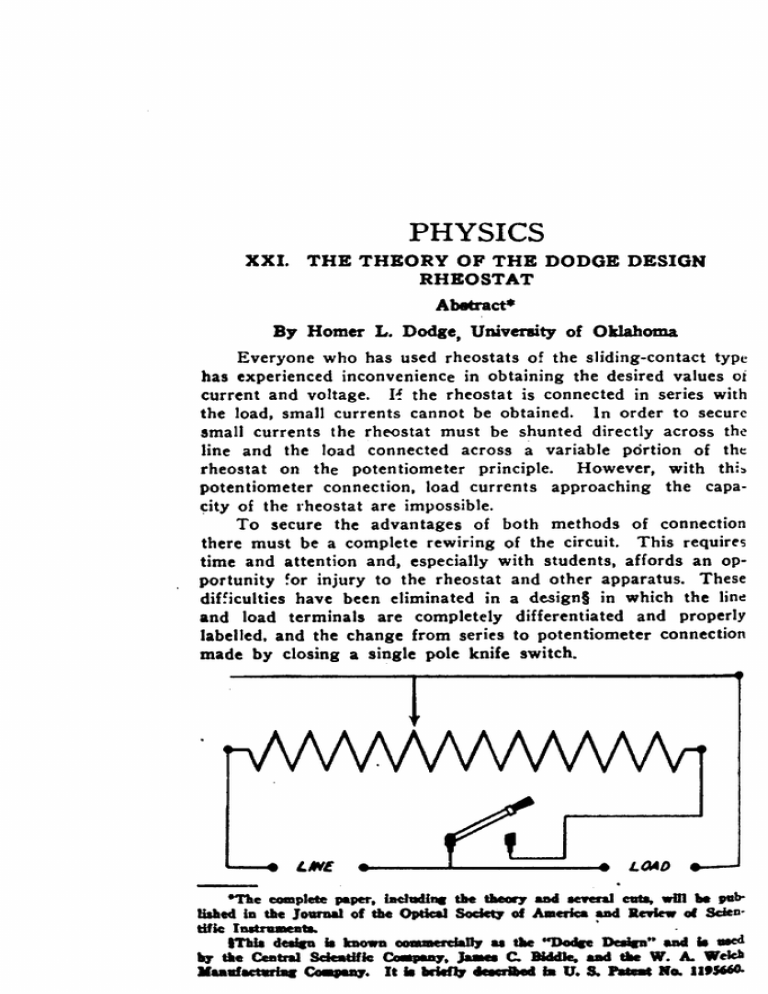
PHYSICS XXI. THE THEORY OF THE DODGE DESIGN RHEOSTAT Abetraet* By Homer L. Dodge, University of Oklahoma Everyone who has used rheostats of the sliding-contact type has experienced inconvenience in obtaining the desired values of current and voltage. H the rheostat is connected in series with the load, small currents cannot be obtained. In order to secure small currents the rhe<lstat must be shunted directly across the line and the load connected across a variable portion of the rheostat on the potentiometer principle. However, with th::. potentiometer connection. load currents approaching the capacity of the rheostat are impossible. To secure the advantages of both methods of connection there must be a complete rewiring of the circuit. This requires time and attention and, especially with students, affords an opportunity !or injury to the rheostat and other apparatus. These dif!iculties have been eliminated in a design§ in which the lin~ and load terminals are completely differentiated and properly labelled. and the change from series to potentiometer connection made by closing a single pole knife switch. L#i£ •• r1__.. . LOAD -TIle complete paper. fael1Illi. tile tIIeor7 UMI Ieftn1 call, will . . pabloamal of the Optical ~ of America UMI RnInr of SdeD- lisIled iD tile ~~I~ . ~ .. alae '"Dodp Daip" . . . . . .-ed 1Q- ... Central ScIeatIfIc ~. Ja- C. BWdIe. tile A. WeJc,Il ITIda deIIp II bowa JI...,ICtWbII~. It .. IIdefJ7 ....... Ia U. S. w. 11'$660- THE OKLAHOMA ACADEMY OF SCIENCE 109 Fig. 1 shows the manner in which this result is accomplished. Tracing the cir~uits, one .£inds that when the switch is open the load is in series with that portion of the winding to the left ot the slider; when the switch is closed, the load is shunted acrou that part of the winding to the right of the slider and at th~ same time the entire winding of the rheostat is connected across the line. With the switch open, values of current up to the full capacity of the rheostat may be secured; with it closed, small values of current and voltage, down to zero, are obtainable. Thr. value of these features is at once apparent. Moreover, they make it practicable to so design the rheostat winding as to accomplish other valuable results. With the' ordinary rheostat, rated by current capacity and resistance, one has no simple means of knowing with what voltage it can be used. Nor can one know whether it is capable of giving overlapping ranges o! current and voltage when used with series and potentiometer connections. That these important factors have been entirely overlooked in the design of laboratory rheostats is due largely to the fact that the prime importance of the voltage as a determining characteristic has been ignored. In practice, a laboratory rheostat is usually used on a definitt" voltage to deliver a certain maximum current. VoltaRe and current capacity should be the determining characteristics. In the present design it is possible to construct a rheostat for a specified voltage and current range, with complete assurance that the rheostat will deliver to any and all loads, any value of current 0:voltage from zero to the maximum. In the complete paper it is shown that for a given applied voltage and current range there is a "worst load", that there i. a certain winding of the rheostat best adapted to thit load. and that the characteristics of this winding can be expressed in terms of the a~plied volage and current range for which the rheo.tat is to be de~igned. A rheostat designed on these principle. i. eaq to connen and manipulate, can be rated in term. of voltage and current capacity which are the natural criteria, and furnilhel the maximum ~ible range of current for a pen applied voltaiC aul1 phyaical dimal.ion•.
